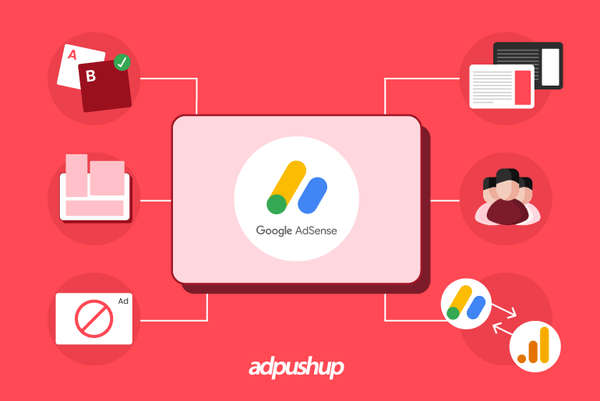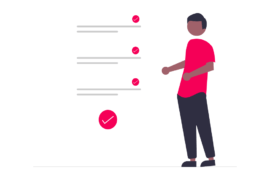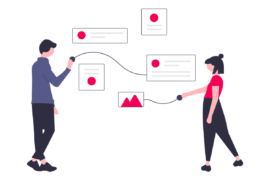Supercharge your Google AdSense revenue with expert strategies and proven techniques to maximize your earnings. Here’s all you need to know.
For many publishers, Google Adsense is a go-to source for monetizing content and earning money. However, simply implementing AdSense on your website is not sufficient to maximize your Google AdSense revenue.
AdSense boasts an impressive customer base of 2 million publishers and annually disburses over $10 billion to its esteemed publishers. However, simply gaining approval is not enough; you must possess a certain finesse to truly maximize its potential.
Achieving AdSense approval is an accomplishment, but ensuring that your website is optimized to its fullest potential is a different ball game altogether. With a staggering 2 million publishers as its clientele, AdSense proves its worth by annually distributing over $10 billion to these esteemed partners. Nonetheless, to truly reap the benefits, you must possess a certain flair for optimization.
In this blog, we will take a look at how you can generate the most possible Google Adsense revenue, its benefits, and more.
How Much Google Adsense Revenue Can You Earn?
The question varies from publisher to publisher. In general, AdSense earnings per 1000 visitors is roughly about $0.2 – $2.5 per 1,000 views.
The AdSense program offers varying amounts based on the industry or niche you focus on when creating content. Different industries attract different advertisers, which can impact the CPC rates and ultimately affect your AdSense income.
To find out your potential Google Adsense earnings potential, you would need to experiment and gather data on your own you need to try it on your own.
How to Calculate Your Google Adsense Revenue?
To find out your potential Google Adsense revenue, you can either calculate it manually or use our Adsense Revenue calculator in an easy manner. All you need is traffic numbers, CTR, and CPC.
Here’s the formula to calculate it.
AdSense Income = (Traffic x CTR x CPC) / 100
Multiply your traffic by your CTR, then multiply the result by your CPC. Finally, divide the value by 100.
If you want to eliminate the hard work, and instantly calculate your adsense revenue, use our adsense earnings calculator.
Top 11 Tips to Increase Your Google Adsense Revenue
One of the most common questions that we often come across is “how to earn money with google AdSense?”. Here are a few Google AdSense revenue tips that will help you optimize your website for both higher revenue and an enhanced user experience.
1. A/B test Your Ad Units

Experimenting allows you to pit one variation of ad settings against another variation and select the one that performs the best.
You can compare the performance of text-only ad units to ad units that have both text and display enabled, or analyze the effect of changing the color of ad text on ad performance, or determine the impact on your revenue by serving ads in the sensitive and/or general categories.
Although you need a little tech-savvy to navigate your way through the entire process of preparing your experiment, creating your experiment, monitoring your experiment, and finally choosing your winner—it’s all well worth the effort.
(Note: If you’re looking for a smarter, automated solution for this, you can try our AI-powered AB Testing solution, which automatically creates multiple variations of the ad for you and then selects the combination that can perform the best for your website).
2. Use Multiple Ad Units to Maximize Conversion
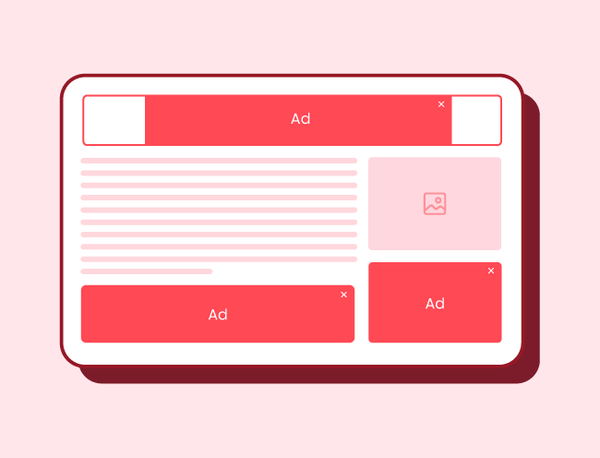
The second tip for increasing your Google Adsense revenue is to use multiple ad units. A simple way to bump up your AdSense click rate and revenue is to place ad units of more than one type (AdSense for content, link, and search) and in different sizes on your pages.
This way, your users are served more ads from Google’s large ad inventory, increasing the probability that they will end up clicking on one of them.
Make sure that the best-located ad on your web page shows up first in your HTML code. This will ensure that your most visible ad real estate is taken by ads that place the highest in the auction—increasing your revenue.
And remember to adhere to the AdSense maximum ad policy, which is up to three AdSense for content units, up to three link units, and up to two search units on each page, to avoid having your account banned.
3. Limit the Number of Ads Above the Fold

In web design terminology, “above the fold” refers to the portions of a web page that are visible without scrolling. When too many ad units are placed above the fold, users get turned off because finding the content that they came in for, gets difficult, and the tendency to exit the page increases. As a result of this, Google now penalizes such pages. Here’s an excerpt from the Google Webmaster Central blog:
“As we’ve mentioned previously, we’ve heard complaints from users that if they click on a result and it’s difficult to find the actual content, they aren’t happy with the experience. Rather than scrolling down the page past a slew of ads, users want to see content right away. So sites that don’t have much content “above-the-fold” can be affected by this change. If you click on a website and the part of the website you see first either doesn’t have a lot of visible content above-the-fold or dedicates a large fraction of the site’s initial screen real estate to ads, that’s not a very good user experience. Such sites may not rank as highly going forward.
4. Optimize the Color Impact of Text Ad Units
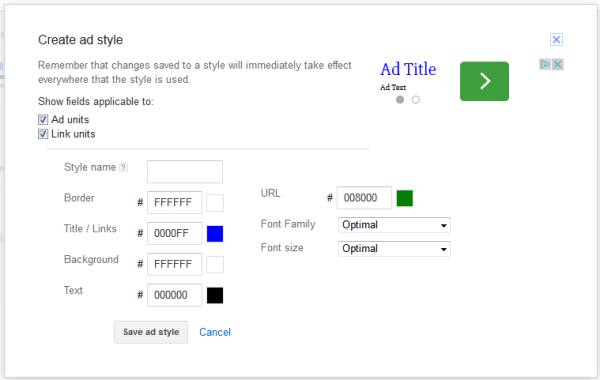
Experimenting with the color of text ad units is essential to increasing their visibility. An ad style that works on a light website theme may look too bright and distracting on a darker one, turning users away not only from the ad but from the web page.
For the most unobtrusive user experience, match the background and border color of the ad unit to the background of the page where the ad will be placed.
For a more distinct ad, match the background and border colors to your website, but don’t match them exactly to where the ads are placed. Try out different styles and measure ad performance over time to settle on the best-performing format.
5. Create and Implement Responsive Ads
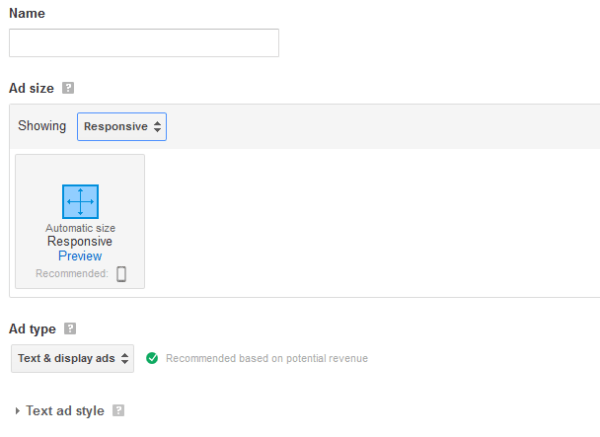
This ties into a larger point of implementing a responsive design on your website (which is something you really need to do if you’re running a website in 2015). Wikipedia explains responsive design as follows:
“Responsive web design (RWD) is an approach to web design aimed at crafting sites to provide an optimal viewing experience—easy reading and navigation with a minimum of resizing, mobile phones).”
Last year, Comscore reported that mobile platforms — smartphones and tablets — combined account for 60% of total digital media time spent, up from 50% a year ago. If your website is not optimized for these devices, you’re missing out on a big opportunity to capture this audience.
So what does this have to do with AdSense, you ask? Well, AdSense plays well with responsive design and allows you to generate codes for responsive ad units, which automatically resize themselves to offer the best viewing experience to the mobile audience. Do this now because that 60% is a number that’s only going to go north.
6. Link your AdSense and Analytics accounts
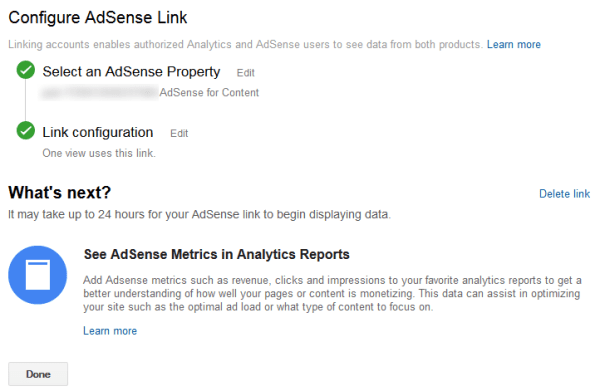
Linking your AdSense and Google Analytics accounts gives you access to AdSense metrics such as revenue, clicks, and impressions, which you can add to your favorite analytics reports to get a better understanding of how well your pages or content is monetizing.
This data can assist in optimizing your site such as the optimal ad load or what type of content to focus on.
Once you’ve linked your properties, you can use insights from Analytics to refine and optimize your AdSense ad units, improving the overall performance of your website.
7. Keep your Design & Content User-focused
In the mad race to increase Google adsense revenue, it’s easy to lose sight of the real goal of why your website or business exists in the first place—to provide value to users.
Use a judicial mix of ads and content so that users are not overwhelmed by the former. Sometimes ads are placed haphazardly on the web page and in between content without any thought to usability or aesthetics.
Even Google says that to get the most of your account, you should first consider the user and then think about anything else. Doing it the other way around is like putting the horse before the cart, it’s never going to work.
8. Publish High-Quality Content on a Regular Basis
This really is the big one for inceasing your Google Adsense revenue, the other points are all just tweaks in one way or another—but when it comes to AdSense earnings, content really is the king. In fact, according to Semrush, 55% websites create more content and post more frequently, whereas 53% are focusing on improving the quality of their content.
Simply put: No traffic, no money; more traffic, more money.
But this is always easier said than done. It helps to publish content about a topic that you’re both interested in and have some level of expertise in, as people will then be more likely to view you as an influencer on your topic.
Google’s algorithm rewards websites that publish content on a regular basis with a higher ranking, and consequently, higher traffic—so make sure your publishing is more predictable than erratic.
Finally, going the extra mile to optimize your content for search engines can yield great results in terms of organic traffic, especially, in the long run, and this will lead to a higher Google Adsense revenue as well.
9. Build an Audience Before Setting up AdSense
Though it may be tempting to set up AdSense on your website right after you’ve published the first piece of content—the temptation is best avoided.
Cluttering your website with ads before anybody really knows about it will likely put visitors off, and consequently, they’ll be less likely to share or link to it. This limits your ability to emerge as an authority in your niche.
Instead, focus on winning a sizable audience in terms of email subscribers, RSS readers, and monthly visitors before you start displaying ads.
10. Go Easy with the Blocking and filtering
Each ad that you block by URL will be one more ad that won’t be bidding for space on your website in the auction—effectively reducing the earning potential of that ad space.
Furthermore, advertisers whose ads you block may decide that they don’t want to advertise with you in the future. The same thing happens when you filter out entire categories but on a larger scale. Don’t block ads unless it’s absolutely necessary.
11. Keep Yourself Updated
Lastly, in an effort to increase your Google AdSense revenue, don’t forget the basics, and that’s sticking to the new trends as well. Google’s help center has this brilliant AdSense optimization overview that you could look at and take ideas from to get more mileage out of your AdSense account.
Now let’s have a look at some of the benefits of using Google Adsense.
How Google AdSense Helps in Generating Revenue for Publishers?
Largest Search Database
When it comes to the benefits of utilizing AdSense, one remarkable advantage stands out: gaining access to the largest search database in the world. With an astonishing number of over 50 billion indexed web pages, the possibilities are truly limitless.
Moreover, nearly 85% of internet users prefer Google search. This statistic speaks volumes about the popularity and trustworthiness of Google as a search engine.
By leveraging AdSense, you tap into this immense user base that love Google search. This translates to increased visibility and exposure for your content, products, or services.
Global Advertiser Reach
With Google’s extensive network of advertisers, publishers have access to a wide range of advertisers from various industries and geographic locations. This increases the chances of finding relevant ads for your audience.
Lucrative Revenue Potential
AdSense offers a revenue-sharing model where publishers earn a portion of the ad revenue generated from their website. According to Google, publishers receive 68% of the revenue, while Google keeps 32%.
Contextual Advertising
To analyze the page’s content, AdSense use contextual targeting. It then display ads that are highly relevant to the content of your website. it delivers targeted ads that align with users’ interests, increasing the likelihood of clicks and higher earnings.
Mobile Optimization
With the number of mobile users projected to reach 7.49 billion by 2025, the focus on mobile ad formats will increase. Thus, Adsense offers mobile-optimized ad formats, ensuring that your ads look great on smartphones and tablets. This enables publishers to tap into the growing mobile advertising market and monetize their mobile traffic effectively.
User-Friendly Interface
AdSense provides a user-friendly interface that allows publishers to easily manage their ad settings, track performance, and access detailed reports. This empowers publishers to optimize their ad placements and make informed decisions to maximize revenue.
Now you must be wondering how and when Google Adsense pays, let’s have a look.
Google AdSense Revenue Calculator
When and How is Google Adsense Revenue Paid?
Google AdSense operates on a monthly payment cycle. At the end of each month, AdSense calculates your income based on the clicks and impressions generated by the ads on your website. However, before finalizing the payment, AdSense conducts a thorough review to ensure the validity of the clicks and impressions.
The review process typically takes a few weeks and aims to identify any false or fraudulent activity that may have occurred. This process is usually completed by the 20th of the following month.
Once the review is finished and your earnings have been validated, Google AdSense initiates the payment process. Payments are generally sent during the last week of the month following the one in which the earnings were accrued. For example, if you earned income in January, the payment for that month would be sent in the last week of February.
How Much Commission Google Adsense Takes?
Google AdSense charges advertisers for clicks on their ads. Publishers receive 68% of the click revenue for regular ads and 51% for AdSense for search. Payments are made monthly when earnings reach $100 or more. Amounts below $100 roll over to the next month. Payment options include a direct transfer or a check.
You can also head to Google’s Payment FAQs for more information.
Final Words
From optimizing ad placements and formats to delivering targeted content and engaging with your audience, taking proactive steps can have a substantial impact on your Google AdSense revenue. Stay dedicated, analyze data, and continue to refine your approach to unlock the full potential of your monetization efforts.
FAQs on Google Adsense Revenue
Earning through Google AdSense requires establishing and managing a website or blog that draws in visitors and showcases pertinent ads provided by Google AdSense. Here’s how you can build a constant revenue stream through AdSense:
Select an adsense niche or subject that aligns with your expertise and passion. Create top-notch, authentic, and captivating content to captivate and maintain an audience on your website or channel. Depending on your chosen content style, establish a website or blog, ensuring it boasts user-friendly features, visual appeal, and easy navigation.
Boosting traffic to your platform is pivotal for enhancing AdSense earnings. Employ diverse tactics like SEO (search engine optimization), social media promotions, guest posts, and networking to attract visitors.
Create an account with Google AdSense. Ensure to provide precise details about your website, encompassing URL, niche, and contact information. Next, implement a thoughtful ad placement strategy, publishing AdSense ads in locations where they are likely to capture attention without hindering user experience. Typical placements include sidebars, and header/footer sections.
Leverage Google AdSense’s reporting tools to monitor revenue, ad effectiveness, and visitor interactions. This dataset empowers you to fine-tune your approaches. You can also experiment with various ad formats, dimensions, and placements to discern the most effective combinations.
Earning $100 per day through Google AdSense necessitates a blend of strategic forethought, unwavering commitment, and effective refinement. Here’s a stepwise approach to guide you in attaining your objective:
Niche Selection: Opt for a niche that strikes a balance between robust demand and modest competition. Niches housing valuable keywords usually yield higher CPC (Cost Per Click) rates, which can contribute to increased earnings.
Creating Quality Content: Direct your efforts towards crafting top-notch, insightful, and captivating content that resonates with your intended audience. The more valuable your content, the greater the likelihood that visitors will engage with your advertisements.
Keyword Exploration: Undertake thorough keyword exploration to pinpoint pertinent keywords with elevated CPC rates. Utilize tools like Google Keyword Planner to unearth keywords for which advertisers are inclined to pay more.
Search Engine Optimization (SEO): Tweak your content to align with search engines, thereby attracting organic traffic. Implement on-page SEO techniques such as strategic keyword usage, crafting meta descriptions, and optimizing images. Consistent Content Generation: Publish fresh content at regular intervals to keep your audience engaged and entice them to return. Frequent updates also signal search engines that your site remains active and pertinent.
Enhancing User Experience (UX): Assure that your website offers a user-friendly interface, is easy to navigate, and functions well on mobile devices. An affirmative user experience prompts visitors to spend more time on your site, heightening the likelihood of ad interactions.
Ad Placement and Design: Exploring Ad Formats: Experiment with diverse ad formats like display ads, text ads, and link units to identify the most effective option for your audience.
Strategic Positioning: Position ads in noticeable yet unintrusive areas that enhance user experience. Common spots include within content, above the visible area upon loading, and within the sidebar.
Keep in mind that realizing a steady income of $100 per day demands patience, unwavering determination, and sustained exertion. Progressing to this earnings level might require a period of growth, so remain dedicated to delivering value to your audience while continuously refining your strategies.
The amount of money you can earn through AdSense from 100,000 views can differ greatly due to various factors. These factors encompass aspects like the content featured on your website or videos, the demographics of your audience, the rate at which users click on ads (known as click-through rate or CTR), and the cost you receive for each ad click (known as cost-per-click or CPC). AdSense functions on a sophisticated algorithm that considers these elements to calculate your earnings.
As a general approximation, many websites and creators of content mention earning roughly $1 to $3 for every 1,000 views, which is referred to as CPM or “cost per mille.” This suggests that for 100,000 views, you could potentially earn between $100 and $300.
Nevertheless, it’s important to emphasize that these figures can vary significantly. Certain niches and industries might offer higher CPC rates, leading to increased earnings, whereas others might have lower rates. Moreover, how well your website performs, where you place your ads, and how engaged your audience is will all influence your earnings. The only reliable way to predict your AdSense earnings is by consistently monitoring your performance over time and making necessary adjustments to optimize your ad strategy.
It’s worth keeping in mind that AdSense represents just one method of monetizing your content. To ensure a steady income, it might be prudent to explore diverse avenues for generating revenue.

Deepak has a keen eye for detail and a deep understanding of the ad tech landscape. Whether it’s through in-depth articles, thought-provoking insights, or compelling storytelling, he’s dedicated to helping people navigate the complex world of ad tech with the simplicity of his words.
